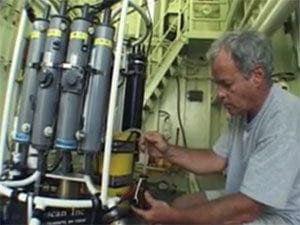Conductivity, Temperature, Depth (CTD) Sensors
What is it and why do we use it?
A CTD — an acronym for Conductivity, Temperature, and Depth — is the primary tool for determining essential physical properties of sea water. It gives scientists a precise and comprehensive charting of the distribution and variation of water temperature, salinity, and density that helps to understand how the oceans affect life.
How does it work?
The shipboard CTD is made up of a set of small probes attached to a large metal rosette wheel. The rosette is lowered on a cable down to the seafloor, and scientists observe the water properties in real time via a conducting cable connecting the CTD to a computer on the ship. A remotely operated device allows the water bottles to be closed selectively as the instrument ascends. A standard CTD cast, depending on water depth, requires two to five hours to collect a complete set of data.Water sampling is often done at specific depths so scientists can learn the physical properties of the water column are at that particular place and time.
Small, low-powered CTD sensors are used on autonomous instruments like the moored profiler, gliders, profiling floats and AUVs .
What platforms are needed?
There can be a host of other accessories and instruments attached to the CTD package. These include Niskin bottles that collect water samples at different depths for measuring chemical properties, Acoustic Doppler Current Profilers (ADCP) that measure the horizontal velocity, and oxygen sensors that measure the dissolved oxygen content of the water.
Advantages and limitations?
Advantages:
Remote sensing
Very accurate
Light weight (CTD only)
Can be used at depths up to several thousand meters
Disadvantages:
The small, low-powered CTD sensors that are used on autonomous instruments like the MP, gliders, profiling floats and AUVs are more complex to operate, the chief limitation is the need to calibrate the individual sensors. This is particularly true for autonomous instruments deployed for long time periods. (Ship-deployed CTDs are referenced with the water sample data which are not generally available with autonomous instrument deployments.) Therefore, the sensors must be stable for the period of deployment, or assumptions about the ocean water properties must be made and referenced to the sensor data. (For example, deep water properties are usually very stable, so autonomous sensor data is adjusted to match the historical water properties at depth. The danger of course is that we miss real changes in the ocean - ship based measurements are still required!)
Sources:
Encyclopedia of Ocean Sciences, vol. 1, p. 579-588

